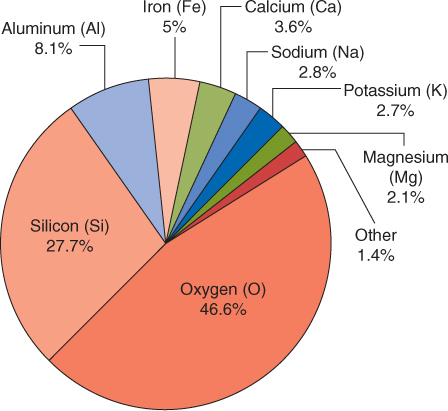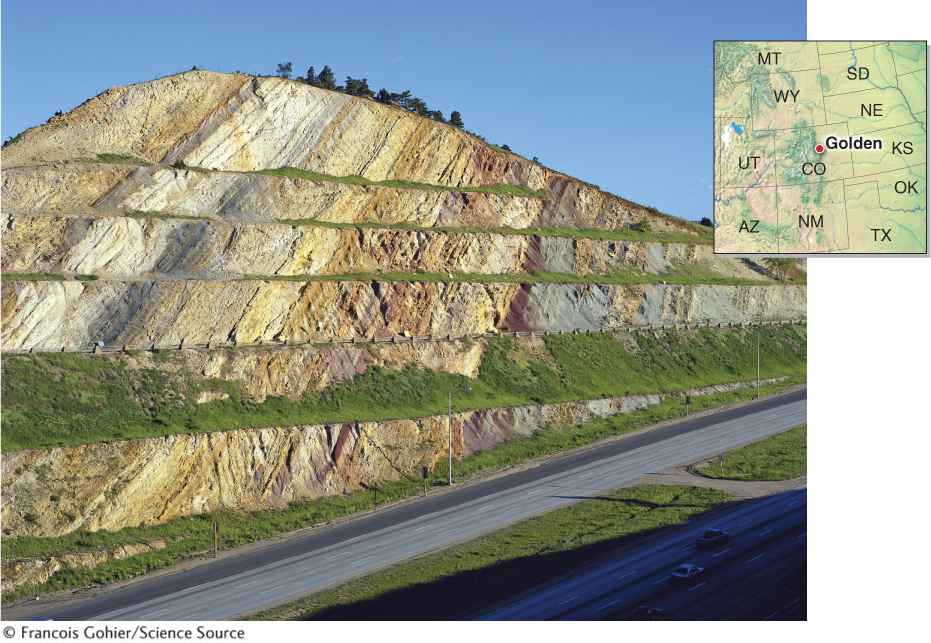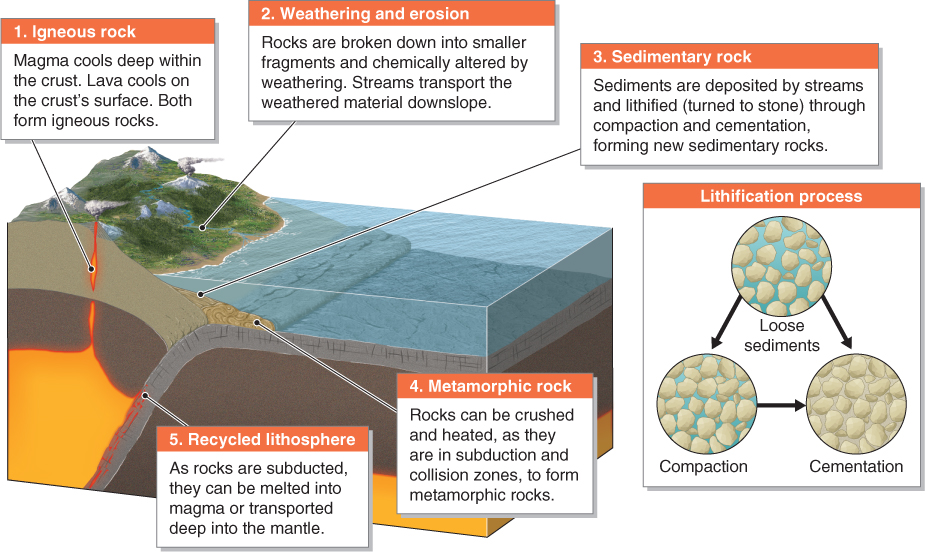13.1 Minerals and Rocks: Building Earth’s Crust
List the main mineral groups that make up rocks and discuss how rocks are formed, transformed, and recycled.
Mineralogists—scientists who study minerals—
mineral
A naturally occurring, crystalline, solid chemical element or compound with a uniform chemical composition.
Question 13.1
Why is ice classified as a mineral?
Ice meets all the criteria for being a mineral: It is solid, crystalline, naturally occurring, and has a uniform chemical composition.
Most types of minerals are very rare and form only where conditions are exactly right. Precious gemstones and metals, including diamond, gold, silver, ruby, opal, sapphire, and jasper, are minerals. But common table salt is also a mineral. Table sugar is crystalline, but it is an organic compound made by living plants, and it is therefore not a mineral. Petroleum is not a mineral because it is liquid.
All minerals form through the process of crystallization, which occurs when atoms or molecules come together in an orderly patterned structure called a crystal. Although crystallization occurs on Earth’s surface, as it does where salt forms, the process of crystallization is most common in subterranean cavities where water circulates and precipitates (deposits) minerals.
crystallization
A process in which atoms or molecules come together in an orderly patterned structure.
Mineral crystals have angular and flat surfaces. As Figure 13.2 shows, the surfaces of crystals can reflect the arrangement of interlocking atoms and molecules that make up the mineral.

Mineral Classes in Rocks
Although there are thousands of minerals, just a few dozen of them make up most rocks in Earth’s crust. Seventy-

There are four main rock-
Silicates: Silicon (Si) and oxygen (O) combine with each other and with other elements to form silicate minerals. Ninety-
The feldspars, another class of silicate minerals, are the most common class of minerals in Earth’s crust. Oceanic crust is the most extensive type of crust and it is composed largely of feldspars.
Oxides: Oxides are formed when other chemical elements combine with oxygen. Iron combined with oxygen, for example, forms the mineral hematite. Hematite gives many rocks a reddish coloration.
Sulfides and sulfates: Sulfides form as sulfur combines with other elements. Sulfates form as sulfur and oxygen combine with other materials. Many sulfide minerals are ores of metals such as lead, zinc, mercury, and copper. Gypsum (CaSO4 · 2H2O) forms when sulfur and oxygen combine with calcium and other elements (Figure 13.4).

Carbonates: Carbonates form when carbon combines with other elements, particularly oxygen. Carbonate minerals such as calcite commonly cement particles of sediment together to form sedimentary rocks. One of the most common carbonate rocks is limestone, composed mostly of calcium carbonate (CaCO3).
Rocks
Most rocks are composed of one or more minerals. A rock is a solid mass composed of minerals or volcanic glass. Some minerals, such as sodium chloride (NaCl), can form rocks on their own, such as rock salt (halite), but most rocks are an assemblage of many minerals cemented or interlocked together. Minerals can be bonded together with a natural cement. They can also interlock tightly into a coherent mass to from a crystalline rock (one possessing crystals).
rock
A solid mass composed of minerals or volcanic glass.
The Geography of Outcrops
Earth’s crust is composed of rocks and covered by sediments derived from rocks. Sediments are accumulations of small fragments of rock and organic material that are not cemented together. Rock fragments, or clasts, are formed by weathering of larger blocks of rock. Clasts are transported by flowing water, ice, or wind and deposited in layers of loose sediments. The sand on a beach, for example, is deposited by flowing rivers and the action of coastal waves. Over most of Earth’s surface, sediments form a veneer that covers the underlying bedrock (rock that is still structurally part of Earth’s crust).
sediment
An accumulation of small fragments of rock and organic material that is not cemented together.
Exposed areas of bedrock, or outcrops, dominate the landscape in tectonically and volcanically active mountainous regions, but there are few outcrops in the flat interior regions of continents, such as the Great Plains of North America, where the bedrock in most places is buried beneath sediments that are hundreds of meters thick or more. Most outcrops are found in mountainous areas, in stream canyons, on rocky coastlines, and where roads have been cut into hills or mountains (Figure 13.5).

outcrop
An exposed area of bedrock.
The Rock Cycle
Rocks come in many types, from soft to hard, light to dark, and in all colors. Some look like human hair, and some are so light they float. The wide array of rock types can be grouped into three broad families: igneous rocks, sedimentary rocks, and metamorphic rocks. Igneous rocks cool from magma or lava. Sedimentary rocks are formed through cementation and compaction of sediments. Metamorphic rocks are formed by heat and pressure applied to preexisting rocks.
igneous rock
Rock that has cooled from magma or lava.
sedimentary rock
Rock formed from compacted and cemented sediments.
metamorphic rock
Rock formed by heat and pressure applied to preexisting rock.
Question 13.2
How are rocks formed?
Rocks are formed from cooled magma or lava, from sediments that are cemented and compacted together, or from preexisting rocks that are heated and compressed under tremendous pressures.
The rock cycle is a conceptual model that describes the formation and transformation of rocks in the crust. In the rock cycle, rocks are formed, transformed from one type to another, and recycled into the mantle (Figure 13.6). Rocks first form when magma cools and hardens (or freezes) into rock from a molten (liquid) state, either deep within Earth’s crust or as lava extruded (pushed out) onto the crust’s surface from a volcanic vent.

rock cycle
A model of the processes by which rocks form, are transformed from one type to another, and are recycled into the mantle.
After rocks harden, they are subject to weathering, a process by which they are reduced to fragments of varying size or chemically broken down. The resulting fragments are transported downslope (mostly by flowing water) and deposited as sediments. Through the processes of compaction and cementation, loose sediments may experience lithification (transformed into rock). Compaction of the sediments occurs as they accumulate and their weight compresses the particles. Cementation is a process in which minerals fill the spaces between sediment particles and bind them together to form sedimentary rock. Most sedimentary rocks are formed through compaction and cementation (see Figure 13.6).
lithification
The formation of sedimentary rock through compaction and cementation of loose sediments.
cementation
A process in which minerals fill the spaces between loose particles and bind them together to form sedimentary rock.
Next in the rock cycle, sedimentary rock can be buried deep in the crust through tectonic collision or subduction (see Section 12.3). There it can be compressed and heated under enormous pressure. Through compression and heating, any rock can become a new metamorphic rock. If a rock is heated enough, it can melt into magma. Thus, through the rock cycle, rocks may be transformed from igneous rock, to sedimentary rock, to metamorphic rock, and back to igneous rock.
This conceptual model of the rock cycle is a good start, but it falls short of capturing the complexity of the process of rock formation and transformation. Rock may take any of several transformational pathways, depending on the tectonic setting in which it is formed. In Figure 13.6, if the metamorphic rock were to be exposed at the crust’s surface, it would be weathered and eroded into sediments. Those sediments could then lithify into sedimentary rock. In another example, seafloor igneous rocks form from cooled magma and lava at mid-
